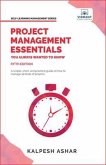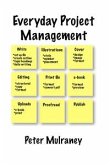Project management is one of the most widely used disciplines in modern business, yet it is often misunderstood or applied inconsistently. It is not simply about creating schedules or tracking budgets; it is about organising people, resources, and processes to achieve clear and measurable outcomes. Every successful project, regardless of its size or industry, depends on the same principles: clarity of purpose, structured planning, effective communication, and disciplined execution. This book was written to make those principles accessible and practical for anyone who manages work, leads teams, or delivers results.
The world of work has changed. Projects are no longer limited to construction sites or engineering firms; they exist in every environment, from software development and marketing campaigns to healthcare, education, and government. The ability to manage projects effectively has become a core professional skill. As organisations face increasing complexity, globalisation, and rapid technological change, project management provides the structure that enables stability and progress.
This book, Introduction to Project Management: A Clear and Concise Guide, is designed for professionals who want to understand how projects work and how to manage them successfully. It avoids unnecessary jargon and focuses on practical application. Each chapter builds logically from the foundations of project management through to planning, control, leadership, and closure. It explains the essential processes, roles, and techniques that form the backbone of effective project delivery, using clear language and straightforward examples suitable for both new and experienced readers.
The book begins by defining what project management is and why it matters. It introduces the role of the project manager and explores the project life cycle, showing how each stage connects to the next. From there, it moves into the practical steps of setting goals, defining scope, and developing plans that balance time, cost, and resources. It examines the tools and techniques that support these processes, from risk registers and Gantt charts to dashboards and communication plans.
The middle chapters focus on execution - how to lead teams, manage stakeholders, and maintain control as work progresses. They explore how to manage uncertainty through risk and issue management, how to monitor performance through data and reporting, and how to maintain quality and focus under pressure. Each concept is explained clearly, with emphasis on how it can be applied in everyday project situations rather than in theory alone.
The later chapters address project closure, lessons learned, and the future of project management. They show how the discipline continues to evolve through digital transformation, artificial intelligence, and new approaches such as Agile and hybrid models. These developments do not replace traditional project management but build upon it, offering more flexibility while maintaining the need for structure and accountability.
Throughout the book, the tone remains practical, factual, and accessible. The intention is not to teach a single methodology but to provide a solid foundation that supports all of them. Whether you use PRINCE2, PMBOK, Agile, or a hybrid framework, the principles discussed here remain relevant. The focus is on developing good habits: planning carefully, communicating clearly, managing risks, and learning continuously.
Dieser Download kann aus rechtlichen Gründen nur mit Rechnungsadresse in A, B, CY, CZ, D, DK, EW, E, FIN, F, GR, H, IRL, I, LT, L, LR, M, NL, PL, P, R, S, SLO, SK ausgeliefert werden.









